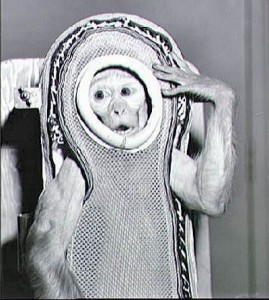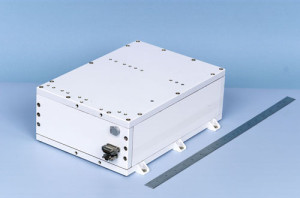That’s where Constellation’s squirrel monkeys come in. NASA plans to spend $1.75 million to inject over two dozen monkeys with huge doses of gamma radiation to see, essentially, what happens. The agency then plans to extrapolate data from the tests, which can make the animals go mad attacking themselves as their teeth fall out as a result of the radiation exposure.
Fry to Fly
The monkey study, yet to be approved by the Brookhaven National Laboratory, is the first of its kind in nearly three decades. The analysis is reminiscent of the experiments done on animals and humans that led to the biological nuclear and chemical wastes that resulted in a dump on Department of Veterans Affairs land in the upscale Los Angeles neighborhood of Brentwood.
Those sometimes-gruesome experiments were condemned by medical professionals and political leaders in the 1990s as part of the larger issue of experimenting with unaware humans who had a variety of radiation tests performed on them in the 1950s and 1960s.
EnviroReporter.com‘s extensive investigation into radiation experiments on animals and people at UCLA and the West LA VA, as reported on in “Where the Bodies are Buried,” suggests that there may be no need to nuke squirrel monkeys as the results are already well known: intense radiation exposure can disable and kill mammals. Thousands of experiments have already shown this.
One of the only known ways to protect against this radiation, lead shielding, would be required in spacecraft and astronauts’ suits and would render spacecraft and astronauts too heavy to be practical. Other ideas, like using the spacecraft’s liquid nitrogen fuel to act as a deflector in the hull, haven’t been tested.
Cosmic rays consist of high energy protons and other nuclei so intense that the Apollo astronauts reported seeing flashes in their eyeballs. The 24 astronauts who made up the Apollo program, the only time men ever in deep space, are too small a number statistically to be able to be scientifically representative but it is thought that they have suffered a higher rate of cancer. Plus the longest flight the Apollo astronauts rode on was less than two weeks.
Estimates of radiation exposure in outer space do exist. An unshielded interplanetary astronaut would receive about 400 to 900 milli-Sieverts (mSv) annually, compared to 2.4 mSv on Earth. Even a ‘shielded’ mission to Mars lasting 30 months would irradiate humans with up to 1,000 mSv (1 Sv) which is approaching the lifetime limit, 1 to 4 Sv, advised for so-called “low Earth orbit activities” of astronauts as determined by the National Council on Radiation Protection and Measurements.
No known shielding would be totally effective against both galactic cosmic rays and higher energy waves that wouldn’t weigh hundreds of metric tons. Even that shielding can cause reflective ‘bounce back’ or secondary radiation exposure.
The radiation in outer space is intense, especially during solar proton events when the Sun emits a solar flare or coronal mass ejections.
NASA found this out the ‘hot’ way when it launched its 2001 Mars Odyssey on April 7, 2001. The spacecraft was designed to measure radiation on the way to Mars and while in the Martian orbit. On board was a sophisticated device called the Martian Radiation Environment Experiment, or MARIE, which started malfunctioning in late 2003 after a series of particularly strong solar flares blasted the spacecraft.
Marie was toasted with particle radiation. MARIE could not be salvaged demonstrating that even robotic missions in outer space aren’t immune from destructive cosmic radiation. The solar proton event that disabled MARIE was not detected on Earth meaning that the radiation was directional and therefore impossible to predict. This could obviously have a deleterious effect on any manned missions to Mars.
Perhaps the answer is in a reassessment of the actual effects of high energy radiation to find out if it isn’t so hot after all.
Irradiating two dozen squirrel monkeys to test their cognitive responses suggests that NASA knows it won’t be able to adequately shield astronauts living on the Moon and traveling to and from Mars. If the monkeys perform effectively even after being dosed with a massive shot of gamma radiation, the argument could be made that humans could do the same. Monkey see, Man do.
Monkeying Around
Scant media attention has paid to the moral and ethical issues surrounding renewed radiation experimentation on primates, let alone the questionable science behind it. Groups like People for the Ethical Treatment of Animals, or PETA, has tried to change that but the effort has barely made a blip on the media radar so far despite a spat of protests.












Before we begin colonizing other planets, we should probably first learn to peacefully coexist with the animals on this planet rather than treating them as resources that we are free to exploit.
Readers can contact NASA Administrator Charles Bolden via PETA’s online Action Alert: http://www.peta.org/nasa
I grew up in the 1960s and we were the dead center target of a generation raised to expect and adore space exploration. It was supposed to prove that we were better than everyone else. Such a sad commentary on what has become the ultimately corrupt core of that concept that its legacy has been reduced to a plan to torture a small group of little monkeys. As Michael points out, we already know what happens when a living creature is nuked with radiation. It is not good. So what is the point? Aside from satiating someone’s sadism or someone’s incomprehensible indifference to suffering, it must ultimately be about a lot of money. A lot. It is always the money.